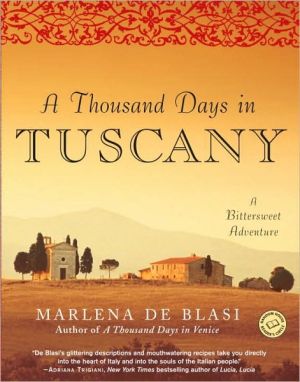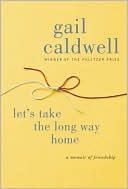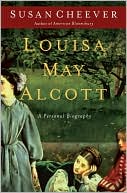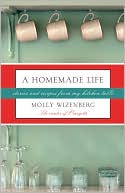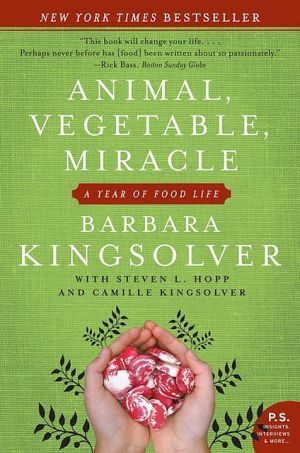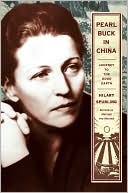A Thousand Days in Tuscany: A Bittersweet Adventure
They had met and married on perilously short acquaintance, she an American chef and food writer, he a Venetian banker. Now they were taking another audacious leap, unstitching their ties with exquisite Venice to live in a roughly renovated stable in Tuscany.\ Once again, it was love at first sight. Love for the timeless countryside and the ancient village of San Casciano dei Bagni, for the local vintage and the magnificent cooking, for the Tuscan sky and the friendly church bells. Love...
Search in google:
American chef Marlena de Blasi and her Venetian husband, Fernando, married rather late in life. In search of the rhythms of country living, the couple moves to a barely renovated former stable in Tuscany with no phone, no central heating, and something resembling a playhouse kitchen. They dwell among two hundred villagers, ancient olive groves, and hot Etruscan springs. In this patch of earth where Tuscany, Umbria, and Lazio collide, there is much to feed de Blasi's two passions--food and love. We accompany the couple as they harvest grapes, gather chestnuts, forage for wild mushrooms, and climb trees in the cold of December to pick olives, one by one. Their routines are not that different from those of villagers centuries earlier.They are befriended by the mesmeric Barlozzo, a self-styled village chieftain. His fascinating stories lead de Blasi more deeply inside the soul of Tuscany. Together they visit sacred festivals and taste just-pressed olive oil, drizzled over roasted country bread, and squash blossoms, battered and deep-fried and sprayed with sea-salted water. In a cauldron set over a wood fire, they braise beans in red wine, and a stew of wild boar simmers overnight in the ashes of their hearth. Barlozzo shares his knowledge of Italian farming traditions, ancient health potions, and artisanal food makers, but he has secrets he doesn't share, and one of them concerns the beautiful Floriana, whose illness teaches Marlena that happiness is truly a choice.Like the pleasurable tastes and textures of a fine meal, A Thousand Days in Tuscany is as satisfying as it is enticing. The author's own recipes are included. Publishers Weekly From its opening scene of an impromptu alfresco village feast of fried zucchini blossoms, fennel-roasted pork, and pudding made from the cream of a local blue-eyed cow, this memoir of the seasons in a small Tuscan village is rich with food, weather, romance and, above all, life. De Blasi continues the adventures begun in her A Thousand Days in Venice, as she and her husband, Fernando, leave Venice for Tuscany in search of "a place that still remembers real life... sweet and salty... each side of life dignifying the other." Fortunately, the two are adopted by Barlozzo, an elderly local eager to share his knowledge of the old ways. He introduces them to the local customs: grape harvesting, truffle hunting, bread baking, etc. Although the book teems with food references, including recipes for intriguing traditional dishes, de Blasi is more than a sunny regional food writer-she digs into the meaning of life. As she fights Fernando's periodic depressions and brings him back to joy, gains Barlozzo's trust and love, learns his troubling lifelong secrets and comes to terms with the death of a beloved friend, she immerses her readers in life's poignancy, brevity and wonder. Agent, Rosalie Siegel. (Nov. 5) Forecast: Fans of Frances Mayes's oeuvre will gravitate to this, as well as those who read A Thousand Days in Venice. Copyright 2004 Reed Business Information.
The scent of them is enough to send up a short, sharp thrill in a hungry person. Seething hot beauties, they repose in a great unruly pile on the white linen. The yellow of the naked blossoms shows through the gilt sheaths of their crackling skin. Skin thin as Venetian glass, I think. But I'm far away from Venice. We live in Tuscany, now. As of this morning, we live in Tuscany. I say it breezily to myself as though it was all in a day's work. Yesterday Venice. Today, San Casciano dei Bagni. And six hours after arrival, here I am already in a kitchen. In the small, steamy kitchen of the local bar watching two white-hatted, pink-smocked cooks preparing antipasti for what seems to have become a village festival.\ The gorgeous things they're cooking are zucchini blossoms, fat and velvety, almost as wide and long as lilies. And the frying dance is precise: drag a blossom quickly through the nearly liquid batter, let the excess drain back into the bowl, lay the blossom gently in the wide, low-hipped pot of hot, very hot shimmering oil. Another blossom and another. Twelve at a time in each of four pots. The blossoms are so light that, as a crust forms on one side, they bob about in the oil and turn themselves over and over until a skimmer is slid in to rescue them, to lay them for a moment on thick brown paper. The paper is then used as a sling to transport the blossoms to a linen-lined tray. One of the cooks fills a red glass bottle with warm, sea-salted water. She fits a metal sprayer onto the bottle and, holding it at arm's length, spritzes the gold blossoms with the salty water. The hot skins hiss and the perfume of them is whipped up and out into the moist June Tuscan breeze.\ Pan-to-hand-to-mouth food, these are sustenance for the twelve-minute interval before supper, and so when the first hundred are ready, the cook, the one called Bice, hands me the tray and says 'vai,' 'go' without looking up. A kitchen directive from one colleague to another, from one chef to another, she says it with familiarity, as though we've worked together for years. But tonight I'm not the chef. I think I'm a guest or am I the hostess? I'm not at all sure how this festival got started but I'm happy it did.\ Happy and still unwashed from the morning's journey, from the afternoon's work, I'm salty as the blossoms I offer to people, who take them without ceremony. The same familiarity is at work here as each one smiles or pats me on the shoulder, says grazie bella, thank you beauty, as if I'd been passing them hot, crisp flowers all my life. I like this. For one moment it occurs that I might run with the basket to some dim corner of the piazza to devour the remaining blossoms myself, eyes half-closed in a lusty swoon among the shadows. But I don't. Some people don't wait until I reach them but come to me, take a flower while sipping wine or talking over their shoulders. People are collecting about me now, rooks swooping in for the things until nothing is left, save errant crumbles, crunchy and still-warm, which I press onto my finger and suck.\ *****\ Deep-Fried Flowers, Vegetables, and Herbs\ 1 1/2 cups all purpose flour\ 2 cups beer\ 1/2 cup cold water\ 2 teaspoons fine sea salt\ 3 ice cubes\ Peanut oil or extra virgin olive oil for frying\ Zucchini blossoms, nasturtium flowers, and borage flowers, rinsed, dried, and stems trimmed\ Celery leaves cut in branches, rinsed, and dried Whole sage leaves, rinsed and dried\ Tiny spring onions or scallions, stems trimmed to about 4 inches in length, rinsed and dried\ Warm sea-salted water in a sprayer\ In a large bowl, beat together with a fork the flour, beer, water, and sea salt to form a thin batter. Let the batter rest for an hour or so, covered and at room temperature. Stir in the ice cubes and let the batter rest for an additional half-hour. Stir the batter again. It should now be smooth and have the texture of heavy cream. If it’s too thick, add cold water by the tablespoonful until the "heavy cream" texture is achieved.\ Over a medium flame, heat the oil in a deep fryer or a heavy pan to a depth of 3". The more slowly the oil heats, the more evenly it will heat, helping you to avoid hot and cold spots and unevenly fried foods. Test the oil by dropping in a cube of bread. If it sizzles and turns golden in a few seconds, the oil is ready.\ Drag the flowers, herbs, and spring onions through the batter, shaking off the excess. Place them into the hot oil and let them bob about for half a minute or so, allowing them to take on a good, dark crust. Turn them with tongs, to finish frying, then remove them with a slotted spoon to absorbent paper towels. Using a virgin plant sprayer, spray each batch immediately with warm sea-salted water and keep them in a 100-degree oven while you fry the next batch. Better, gather people around the stove and eat the things pan to hand to mouth. A very informal first course.
ContentsPROLOGUE 1Summer1 The Gorgeous Things They're Cooking Are Zucchini Blossoms 72 Figs and Apples Threaded on Strings 303 The Valley Is Safe, and We Will Bake Bread 644 Are You Making a Mattress Stuffed with Rosemary? 815 Sit the Chicken in a Roasting Pan on a Pretty Bed of Turnips and Onions, Leeks and Carrots 90Fall6 Vendemmiamo--Let's Pick Those Grapes 1057 Dolce e Salata, Sweet and Salty--Because That's How Life Tastes to Me 1248 Now These Are Chestnut Trees 1509 Do Tuscans Drink Wine at Every Meal? 170Winter10 Perhaps as a Genus, Olives Know Too Much 19511 December Has Come to Live in the Stable 21812 Supper Made from Almost Nothing 24813 Fasting Was How We Were Living Anyway 264Spring14 Virtuous Drenches 29315 Florì and I Are Shelling Peas 30316 The First of the Zucchini Blossoms Are Up 314RecipesDeep-Fried Flowers, Vegetables, and Herbs 28The Holy Ghost's Cherries 62Schiacciata Toscana, Tuscan Flatbread (or "Squashed" Breads) 79Winemaker's Sausages Roasted with Grapes 120Fagioli al Fiasco sotto le Cenere, Beans Braised in a Bottle under the Cinders 122Braised Pork to Taste Like Wild Boar 147Castagnaccio 192The One and Only True Bruschetta (brew-sket'-ah)What It Is and How to Pronounce It 247A Tasting of Pecorino Cheeses with Chestnut Honey 301
\ From Barnes & NobleIn search of "a place that still remembers real life…sweet and salty…each of life dignifying the other," American chef Marlena de Blasi and her Venetian husband set out for Tuscany. In a small village, surrounded by ancient olive groves, they settled into a rudimentary lifestyle that lacked most amenities. (Their new home, a former stable, had no phone or central heating, and only a paltry excuse for a kitchen.) Yet despite the small privations, they flourished; harvesting grapes, gathering chestnuts, foraging for wild mushrooms. A talkative village elder named Barlozzo introduced them to the old ways of this tiny rural community, initiating them into Tuscan traditions and values. An enticing invitation to an unspoiled place.\ \ \ \ \ Publishers WeeklyFrom its opening scene of an impromptu alfresco village feast of fried zucchini blossoms, fennel-roasted pork, and pudding made from the cream of a local blue-eyed cow, this memoir of the seasons in a small Tuscan village is rich with food, weather, romance and, above all, life. De Blasi continues the adventures begun in her A Thousand Days in Venice, as she and her husband, Fernando, leave Venice for Tuscany in search of "a place that still remembers real life... sweet and salty... each side of life dignifying the other." Fortunately, the two are adopted by Barlozzo, an elderly local eager to share his knowledge of the old ways. He introduces them to the local customs: grape harvesting, truffle hunting, bread baking, etc. Although the book teems with food references, including recipes for intriguing traditional dishes, de Blasi is more than a sunny regional food writer-she digs into the meaning of life. As she fights Fernando's periodic depressions and brings him back to joy, gains Barlozzo's trust and love, learns his troubling lifelong secrets and comes to terms with the death of a beloved friend, she immerses her readers in life's poignancy, brevity and wonder. Agent, Rosalie Siegel. (Nov. 5) Forecast: Fans of Frances Mayes's oeuvre will gravitate to this, as well as those who read A Thousand Days in Venice. Copyright 2004 Reed Business Information.\ \ \ Library JournalPicking up where her A Thousand Days in Venice left off, American author and chef de Blasi and her Italian husband trade their stable life in Venice for a potentially idyllic Tuscan one. Taken under the wing by a local who mentors her foray into the ways of the past, the author participates in every aspect of the local food culture, from harvesting grapes to truffle hunting, and vividly describes her adopted community through its preparation and celebration of food. Equal parts an exploration of Tuscan food and culture and a touching story of its people, this book supplemented with complementary recipes reads more like a novel than the memoir it is. Recommended for public libraries and larger cooking collections. Sheila Kasperek, Mansfield Univ. Lib., PA Copyright 2004 Reed Business Information.\ \ \ \ \ Kirkus ReviewsAnother savory slice of de Blasi's life (A Thousand Days in Venice, 2002, etc.), this one chronicling her move south to a small Tuscan town. "Three years ago, when I left America to come to live in Italy, it was neither Venice nor the house on the beach that lured me. Rather it was this man, this Fernando. It's quite the same thing now. We've hardly come to Tuscany for the house." Which is a good thing, for this old stable is far from chic. That's not the point; they have come there to scrub their lives as if with a loofa, to follow the rituals of rural culture in San Casciano dei Bagni, a place of olive and cypress trees, meadows with sheep and sunflowers and lavender. Food will take center stage: fat and velvety zucchini blossoms; a haunch of boar; pecorino bread; ropes of pasta dressed with green tomatoes, garlic, oil, and basil; all the humble, inspired dishes that make you want to bark with pleasure. Without fanfare, the townspeople can gather in a spontaneous convocation, "whispering gastronomic lore like vespers." De Blasi faithfully catches San Casciano in all its weathers, evoking its ancient roots (Roman legions tramped through this land), its artistic association (Rafaello and Perugino), and its political leanings (more than slightly red), as well as the wartime ingenuity that remains a wonder half a century later. The inhabitants, each in their own way, tilt de Blasi's days, making them sweeter and more pungent. One old soul advises on all things San Casciano; another woman makes sure the couple doesn't get too sentimental as they get evermore romantic. The proceedings entail both comfort and risk: the sun shines pink, and the stone floors deliver a welcome coolness, but theswift passage of time lends an edge with the prospect of death. An object lesson in living fully from a genuine sensualist unabashed by her emotions.\ \
